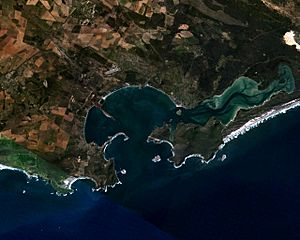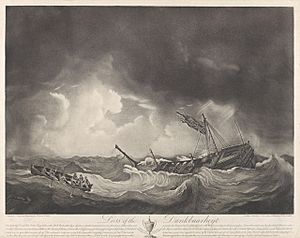Battle of Saldanha Bay (1781) facts for kids
Quick facts for kids Battle of Saldanha Bay |
|||||||
|---|---|---|---|---|---|---|---|
| Part of the Fourth Anglo-Dutch War | |||||||
 Present day Saldanha Bay |
|||||||
|
|||||||
| Belligerents | |||||||
| Commanders and leaders | |||||||
| George Johnstone | Gerrit Harmeyer | ||||||
| Strength | |||||||
| 12 warships + 7 armed transports | 8 vessels of the Dutch East India Company | ||||||
| Casualties and losses | |||||||
| none | light 5 ships captured 1 ship destroyed |
||||||
The Battle of Saldanha Bay was a naval fight that happened near the Dutch Cape Colony on July 21, 1781. It took place during the Fourth Anglo-Dutch War. A group of Royal Navy ships, led by Commodore George Johnstone, captured five ships belonging to the Dutch East India Company. The crew of a sixth Dutch ship destroyed it themselves. There were no British casualties. The Dutch had very few, if any, losses.
Contents
Why the Battle Happened
Commodore Johnstone was ordered to capture the Dutch settlement at the Cape of Good Hope. But France found out about his plan. The French admiral, Bailli de Suffren, stopped Johnstone's mission. Suffren was on his way to the Indian Ocean. The French government warned him about Johnstone. So, Suffren tried to reach the Cape before Johnstone.
The two fleets met by chance near the Cape Verde Islands. This happened on April 16, 1781, in what was called the Battle of Porto Praya. Neither side won that battle. Suffren then sailed to the Cape. Johnstone stayed at Porto Praya to fix his ships. When Johnstone arrived at the Cape in July, the Dutch settlement was well defended. He decided not to attack.
The Dutch governor, Joachim van Plettenberg, took a safety step. He told the Dutch merchant ships, which were full of goods, to anchor in Saldanha Bay. They were to wait there for French ships to escort them. This bay also helped hide them from the British fleet. The Dutch ships had orders to run aground and burn their ships if the British appeared. However, they were not keeping a careful watch.
One of Johnstone's smaller warships, called a frigate, was flying French flags. It stopped a Dutch merchant ship that had left Saldanha Bay a few days earlier. This Dutch ship was the Held Woltemade. It had sailed from Saldanha Bay on June 28. It was carrying supplies and a lot of money (about £40,000 in bullion) to Ceylon. The Held Woltemade surrendered to HMS Active on July 1. From this captured ship, Johnstone learned where the rest of the Dutch fleet was hiding.
The Battle
When Johnstone reached Saldanha Bay, he saw the Dutch fleet. He entered the bay still flying French flags. Then, he quickly raised the British flag and started firing. This completely surprised the Dutch. The Dutch ships could not escape. They decided to destroy their ships rather than let the British capture them.
The Dutch cut their anchor ropes and loosened their top sails. This made their ships drift onto the shore. Once on shore, they tried to set the ships on fire. The British, now in their smaller boats, tried to put out the fires. The British were successful. They captured four ships: Dankbaerheid, Paerl, Honcoop, and Hoogcarspel.
However, the ship Middelburg burned very strongly. The British left it alone. It later blew up, almost hitting two of the captured ships.
A British sloop named Rattlesnake surprised and captured a small coastal boat called a hooker. This hooker was full of the sails from the captured Dutch ships. It was hidden behind Schapin (Schaapen) Island. The Dutch had put the sails on board and hidden the hooker. They hoped this would make it harder for the British to take their large merchant ships.
By the end of the day, the British had captured two more hookers. Johnstone could not easily take these away. He decided to give them back to the Dutch. He did not want to leave any signs of "barbarity" towards a place that had often helped his ships.
What Happened Next
After the British Royal Navy captured the Dutch East Indiamen ships, a boat rowed out to meet the British warships. On board were the "kings of Ternate and Tidore, and the princes of the respective families." The Dutch had kept these important people as prisoners for a long time on Isle Robin. They had then moved them to Saldanha Bay.
The British sent their captured ships back to England. Only two of them reached their destination. Even those two had trouble and faced some fighting in the English Channel. A French frigate attacked Hoogcarspel, but it managed to reach Mount's Bay and was then escorted safely. Also, two French privateer ships attacked Paerl, but it managed to escape.
The ships Dankbaerheid and Honcoop were lost in January 1782. They sank during a strong storm at the mouth of the English Channel. The crew on Dankbaerheid who were taking it to England managed to escape. They reached Lisbon safely. The Honcoop disappeared completely. It was believed to have sunk with everyone on board.
The British had insurance on their captured ships. So, even when Dankbaerheid and Honcoop were lost, the British still got money from the insurance. The total prize money for Paerl and Hoogcarspel was £68,000. This money was shared between Johnstone's naval squadron and the army led by General Sir William Meadows.
Dutch Ships Captured
The information below is about the Dutch ships captured at Saldanha Bay.
| Name | Master | Size (Tons) | Guns | Journey | Notes |
|---|---|---|---|---|---|
| Dankbaerheid | Hendrik Steetsel | 1000 | 24 | Bengal to Rotterdam | Lost on the way to England. Built in 1772. |
| Paerl (or Paarl) | Dirk Cornelisz. Plokker | 1100 | 20 | China to Amsterdam | Built in 1778. |
| Honcoop (or Hencoop) | Axellandt | 1100 | 20 | China to Amsterdam | Lost on the way to England. Built in 1770. |
| Hoogcarspel | Gerrit Harmeir | 1100 | 20 | China to Amsterdam | Built in 1771. |
| Held Woltemade | Swerus Vrolyk | 1100 | 14 | Amsterdam to Ceylon | Captured before the main battle. |
| Middelburg | Justus van Gennep | 1100 | 24 | China to Amsterdam | Burned and destroyed. Built in 1775. |
Johnstone's Squadron
These are the warships that were part of Commodore Johnstone's group:
- HMS Hero (74 guns)
- HMS Monmouth (64 guns)
- HMS Isis (50 guns)
- HMS Jupiter (50 guns)
- HMS Romney (50 guns)
- HMS Jason (36 guns)
- HMS Active (32 guns)
- HMS Diana (28 guns)
- HMS Rattlesnake (16 guns; a sloop, which is a smaller warship)
- HMS Lark (16 guns; a sloop)
- HMS Infernal (a fireship, used to set enemy ships on fire)
- HMS Terror (a bomb vessel, used for shelling targets on land)
Besides these warships, the following armed transport ships also shared in the prize money for the Paerl and Hoogkarspel: San Carlos, Porpoise, Raikes, Royal Charlotte, Resolution, Manilla, and Pondicherry.


